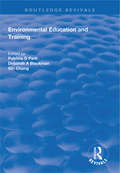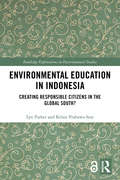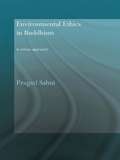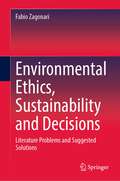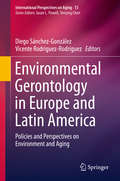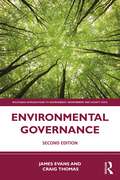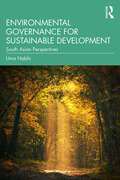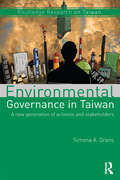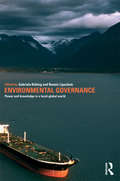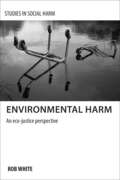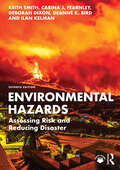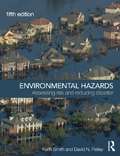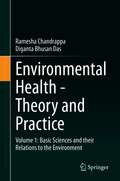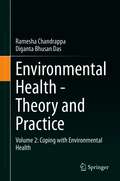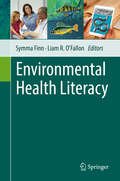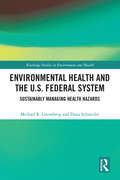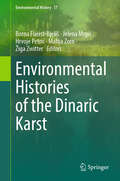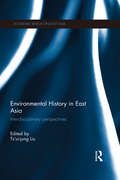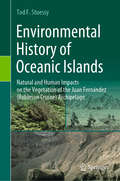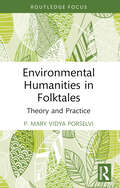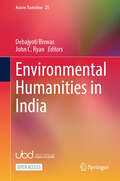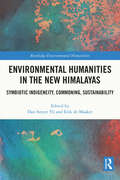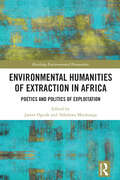- Table View
- List View
Environmental Education and Training (Routledge Revivals)
by Gin Chong Patricia D. Park Deborah A. BlackmanPublished in 1998, the impact of current organizational behaviour upon the environment and concern over the long term effects has become almost a household topic. There are a growing number of reference books which discuss the various aspects and importance of this matter, but they often do so in isolation from the environment, education, and training. In addition to this, little has been discussed about the inter-relationships between the various aspects of organizational behaviour and its impact on the environment. This book intends to bridge the gap. It discusses the importance of environmental education and training in three different disciplines: the legal aspects, financial implications, and managerial choices and decision-making.
Environmental Education in Indonesia: Creating Responsible Citizens in the Global South? (Routledge Explorations in Environmental Studies)
by Lyn Parker Kelsie Prabawa-SearIndonesia’s wealth of natural resources is being exploited at breakneck speed, and environmental awareness and knowledge among the populace is limited. This book examines how young people learn about the environment to see how education can help to develop environmental awareness and avert vast environmental destruction, not only in Indonesia, but also in the Global South more generally. Based on in-depth studies conducted in the cities of Yogyakarta and Surabaya, complemented with surveys of students in secondary schools, Environmental Education in Indonesia examines educational curricula, pedagogy and "green" activities to reveal what is currently being done in schools to educate children about the environment. The book investigates the shortcomings in environment education, including underqualified teachers, the civil service mentality, the still-pervasive chalk-and-talk pedagogy and the effect of the examination system. It also analyses the role of local government in supporting (or not) environmental education, and the contribution of environmental NGOs. The book establishes that young people are not currently being exposed to effective environmental education, and the authors propose that the best and most culturally appropriate way forward in Indonesia is to frame pro-environment behaviour and responsibility as a form of citizenship, and specifically that environmental education should be taught as a separate subject. This book will be of great interest to students and scholars of contemporary Indonesia and Southeast Asia, education for sustainability and environmental education, as well as sustainability and sustainable development more generally.
Environmental Ethics in Buddhism: A Virtues Approach (Routledge Critical Studies in Buddhism)
by Pragati SahniEnvironmental Ethics in Buddhism presents a logical and thorough examination of the metaphysical and ethical dimensions of early Buddhist literature. The author determines the meaning of nature in the early Buddhist context from general Buddhist teachings on dhamma, paticcasamuppada, samsara and the cosmogony of the Agganna Sutta. Consequently, the author shows that early Buddhism can be understood as an environmental virtue ethics. To illustrate this dimension, the Jatakas are used as a source. These are a collection of over five hundred folk tales, which also belong to early Buddhist literature. This work gives an innovative approach to the subject, which puts forward a distinctly Buddhist environmental ethics that is in harmony with traditional teachings as well as adaptable and flexible in addressing environmental problems.
Environmental Ethics, Sustainability and Decisions: Literature Problems and Suggested Solutions
by Fabio ZagonariThis book provides a summary of the main concepts involved in environmental ethics, sustainability and decisions and a consistent sequence of environmental ethics, sustainability and decisions. It presents many environmental ethics, by focusing on maximising welfare within teleological approaches and minimising inequalities within deontological approaches. It presents many sustainability paradigms, by focusing on weak sustainability to maximise welfare and strong sustainability to minimise inequalities. Two main decisions are presented by focusing on policies (taxes, standards, subsidies, permits, protected areas, exploitation rights) and projects (CBA) towards efficiency to maximise welfare and policies (national laws/regulations, bilateral/multilateral agreements) and projects (MCA) towards equity to minimise inequalities.
Environmental Ethics: Theory in Practice
by Ronald SandlerAn accessible yet rigorous introduction to the field, Environmental Ethics: Theory in Practice helps students develop the analytical skills to effectively identify and evaluate the social and ethical dimensions of environmental issues. Covering a wide variety of theories and critical perspectives, author Ronald Sandler considers their strengths and weaknesses, emphasizes their practical importance, and grounds the discussions in a multitude of both classic and contemporary cases and examples.
Environmental Gerontology in Europe and Latin America
by Diego Sánchez-González Vicente Rodríguez-RodríguezThis book looks at the relationships between the physical-social environment and the elderly in Europe and Latin America, from the Environmental Gerontology perspective and through geographical and psychosocial approaches. It addresses the main environmental issues of population ageing, based on an understanding of the complex relationships, adjustments and adaptations between different environments (home, residence, public spaces, landscapes, neighbourhoods, urban and rural environment) and the quality of life of the ageing population, associated with residential strategies and other aspects related to health and dependency. The different levels of socio-spatial analysis are also explored: macro (urban and rural environments, regions and landscapes), meso (neighbourhood, public space) and micro (personal, home and institution). New theoretical and methodological approaches are proposed to analyse the attributes and functions of the physical-social environment of the elderly, as well as new ways of living the ageing process. All will have to respond to the challenges of urbanisation, globalisation and climate change in the 21st century. Also, the different experiences and challenges of public planning and management professionals involved with the growing ageing population are presented, and will require greater association and collaboration with the academic and scientific fields of Environmental Gerontology.
Environmental Governance (Routledge Introductions to Environment: Environment and Society Texts)
by Craig Thomas James EvansClimate change is prompting an unprecedented questioning of the fundamental bases upon which society is founded. Businesses claim that technology can save the environment, while politicians champion the role of international environmental agreements to secure global action. Economists suggest that we should pay developing countries not to destroy their forests, while environmentalists question whether we can solve ecological problems with the same thinking that created them. As the process of steering society, governance has a critical role to play in coordinating these disparate voices and securing collective action to achieve a more sustainable future. Environmental Governance is the only book to discuss the first principles of governance, while also providing a critical overview of the wide-ranging theories and approaches that underpin policy and practice today. It places governance within its wider political context to explore how the environment is controlled, manipulated, regulated and contested by a range of actors and institutions. This book shows how network and market governance have shaped current approaches to environmental issues, while also introducing approaches such as transition management and adaptive governance. In so doing, it highlights the strengths and weaknesses of the different approaches currently in play, and considers their political implications. This second edition has been comprehensively updated to build upon the success of the acclaimed first edition, with a new chapter on the environmental governance of outer space and updated analysis of international climate change summits. It provides a ground-breaking overview of dominant and emerging approaches of environmental governance, forging critical links between them. Each chapter has been updated with new case studies, key debates and figures, and includes questions for discussion and further reading. It is essential reading for students of the environment, politics and sociology, and, indeed, anyone concerned with changing society to secure a more sustainable future.
Environmental Governance for Sustainable Development: South Asian Perspectives
by Uma NabhiThis book studies the role of the United Nations Environment Programme (UNEP) as an advocate for greater environmental responsibility and analyses the major achievements and outcomes of two landmark conferences – Stockholm (1972) and Rio (1992) – which set the agenda for the future role of the UNEP. It discusses the UNEP’s evolution, objectives and the problems of differing perspectives within, its ability to deal with environmental challenges, its skill in successfully carrying out the mandate and contributing to the pursuit of environmental security. The book also looks at five developing countries of South Asia, namely India, Bangladesh, Nepal, Pakistan and Sri Lanka, to study the role of the South Asia Co-operative Environment Programme (SACEP), which plays an active role in the management of environmental issues and constitutes an important landmark in regional cooperation in South Asia. The author evaluates the contributions of National Conservation Strategies not only in creating environmental awareness but also in strengthening environmental governance architecture by integrating Millennium Development Goals and Sustainable Development Goals into the development planning of these South Asian countries under study. Drawing on in-depth research and interviews, this book will be of interest to students, teachers, researchers, policymakers and strategic analysts working in the fields of environment studies, sustainable development, environmental science and policy, environmental law and governance, geography, politics and international affairs.
Environmental Governance in Taiwan: A New Generation of Activists and Stakeholders (Routledge Research on Taiwan Series)
by Simona A. GranoThree decades of rapid industrialization until the lifting of martial law in 1987, with little or no concern for the environment, have made Taiwan’s environmental degradation a serious problem. In the past twenty years, Taiwan has seen a surge of environmental organizations, which to a certain degree have enjoyed a remarkable success in fighting polluting industries or affecting policies on behalf of the environment. This book aims to analyse environmental governance mechanisms and actors in Taiwan through a multi-disciplinary research approach. Based on extensive and original research, it includes four different case studies, which have all taken place since 2011. It focuses on four major elements of governance - specifically norms, actors, processes, and outcomes - to examine Taiwan’s national and local environmental governance in the post-2008 period. The book shows how the painful lessons Taiwan has learned throughout its transition should be of interest to other developing countries, illustrating how these positive transformations have managed to bring about a more ecologically friendly mode of economic development. Demonstrating that the battle to further ecological sustainability is also a battle to further democratisation, this book will be of interest to students and scholars of Taiwan Studies, Developmental Studies and Environmental Studies.
Environmental Governance: Power and Knowledge in a Local-Global World (Suny Series In International Environmental Policy And Theory Ser.)
by Gabriela Kütting Ronnie D. LipschutzThis edited collection makes a highly significant critical contribution to the field of environmental politics. It argues that the international-level, institutionalist approach to global environmental politics has run its course, employed solely by powerful actors in order to orchestrate and manipulate local communities within a continuing hegemonic system. The outstanding international line-up of contributors to this volume explore the real advances that are being made in the areas were the local and global intersect and how power fits into the equation. They explore the relationship between governance, power and knowledge, using power as the main analytical tool. The contributors adopt a variety of approaches and perspectives – some starting from the local level and shifting upward to the global, and some using a global perspective that narrows down to the local. Some chapters explore specific case studies and others employ a more conceptual framework – but all of them bring a new dimension to the relationship between power and knowledge in environmental governance. Power here is explored in all its guises – from relational to structural power. An important and timely exploration of a topic at the forefront of global debate, Environmental Governance is essential reading for all students of global environmental politics, international political economy and international relations.
Environmental Harm: An Eco-Justice Perspective (Studies in Social Harm)
by Rob WhiteThis unique study of social harm offers a systematic and critical discussion of the nature of environmental harm from an eco-justice perspective, challenging conventional criminological definitions of environmental harm. The book evaluates three interconnected justice-related approaches to environmental harm: environmental justice (humans), ecological justice (the environment) and species justice (non-human animals). It provides a critical assessment of environmental harm by interrogating key concepts and exploring how activists and social movements engage in the pursuit of justice. It concludes by describing the tensions between the different approaches and the importance of developing an eco-justice framework that to some extent can reconcile these differences. Using empirical evidence built on theoretical foundations with examples and illustrations from many national contexts, ‘Environmental harm’ will be of interest to students and academics in criminology, sociology, law, geography, environmental studies, philosophy and social policy all over the world.
Environmental Hazards: Assessing Risk and Reducing Disaster
by Keith Smith Deborah Dixon Ilan Kelman Carina J. Fearnley Deanne K. BirdThe seventh edition of Environmental Hazards provides a much expanded and fully up-to-date overview of all the extreme environmental events that threaten people and what they value in the 21st century globally. It integrates cutting-edge materials to provide an interdisciplinary approach to environmental hazards and their management, illustrating how natural and human systems interact to place communities of all sizes, and at all stages of economic development, at risk. Part 1 defines basic concepts of hazard, risk, vulnerability and disaster and explores the evolution of hazards theory. Part 2 employs a consistent chapter structure to demonstrate how individual hazards occur, their impacts and how the risks can be assessed and managed. This extensively revised edition includes: Fresh perspectives on the reliability of disaster data, disaster risk reduction, risk and disaster perception and communication, and new technologies available to assist with environmental hazard management The addition of several new environmental hazards including landslide and avalanches, cryospheric hazards, karst and subsidence hazards, and hazards of the Anthropocene More boxed sections with a focus on both generic issues and the lessons to be learned from a carefully selected range of up-to-date extreme events An annotated list of key resources, including further reading and relevant websites, for all chapters More colour diagrams and photographs, and more than 1,000 references to some of the most significant and recent published material. New exercises to assist teaching in the classroom, or self-learning This carefully structured and balanced textbook captures the complexity and dynamism of environmental hazards and is essential reading for students across many disciplines including geography, environmental science, environmental studies and natural resources.
Environmental Hazards: Assessing Risk and Reducing Disaster
by Keith Smith Deborah Dixon Ilan Kelman Carina J. Fearnley Deanne K. BirdThe seventh edition of Environmental Hazards provides a much expanded and fully up-to-date overview of all the extreme environmental events that threaten people and what they value in the 21st century globally. It integrates cutting-edge materials to provide an interdisciplinary approach to environmental hazards and their management, illustrating how natural and human systems interact to place communities of all sizes, and at all stages of economic development, at risk. Part 1 defines basic concepts of hazard, risk, vulnerability and disaster and explores the evolution of hazards theory. Part 2 employs a consistent chapter structure to demonstrate how individual hazards occur, their impacts and how the risks can be assessed and managed.This extensively revised edition includes: Fresh perspectives on the reliability of disaster data, disaster risk reduction, risk and disaster perception and communication, and new technologies available to assist with environmental hazard management The addition of several new environmental hazards including landslide and avalanches, cryospheric hazards, karst and subsidence hazards, and hazards of the Anthropocene More boxed sections with a focus on both generic issues and the lessons to be learned from a carefully selected range of up-to-date extreme events An annotated list of key resources, including further reading and relevant websites, for all chapters More colour diagrams and photographs, and more than 1,000 references to some of the most significant and recent published material New exercises to assist teaching in the classroom, or self-learning This carefully structured and balanced textbook captures the complexity and dynamism of environmental hazards and is essential reading for students across many disciplines including geography, environmental science, environmental studies and natural resources.
Environmental Hazards: Assessing Risk and Reducing Disaster
by Keith SmithThe expanded fifth edition of Environmental Hazards provides a balanced overview of all the major rapid-onset events that threaten people and what they value in the twenty-first century. It integrates cutting-edge material from the physical and social sciences to demonstrate how natural and human systems interact to place communities of all sizes, and at all stages of economic development, at risk. It also shows how the existing losses to life and property can be reduced. Part I of this established textbook defines basic concepts of hazard, risk, vulnerability and disaster. Critical attention is given to the evolution of theory, to the scale of disaster impact and to the various strategies that have been developed to minimise the impact of damaging events. Part II employs a consistent chapter structure to explain how individual hazards, such as earthquakes, severe storms, floods and droughts, plus biophysical and technological processes, create distinctive patterns of loss throughout the world. The ways in which different societies make a positive response to these threats are placed in the context of ongoing global change. In this extensively revised edition: An entirely new and innovative chapter explains how modern-day complexity contributes to the generation of hazard and risk Additional material supplies fresh perspectives on landslides, biophysical hazards and the increasingly important role of global-scale processes The increased use of boxed sections allows a greater focus on significant generic issues and offers more opportunity to examine a carefully selected range of up-to-date case studies Each chapter now concludes with an annotated list of key resources, including further reading and relevant websites. Environmental Hazards is a well-written and generously illustrated introduction to all the natural, social and technological events that combine to cause death and destruction across the globe. It draws on the latest research findings to guide the student from common problems, theories and policies to explore practical, real-world situations. This authoritative, yet accessible, book captures both the complexity and dynamism of environmental hazards and has become essential reading for students of every kind seeking to understand the nature and consequences of a most important contemporary issue.
Environmental Health - Theory and Practice: Volume 1: Basic Sciences and their Relations to the Environment
by Ramesha Chandrappa Diganta Bhusan DasThis two-volume work discusses environmental health, the branch of public health concerned with all aspects of the natural and built environment affecting human health, and addresses key issues at the global and local scales. The work offers an overview of the methodologies and paradigms that define this burgeoning field, ranging from ecology to epidemiology, and from pollution to environmental psychology, and addresses a wide variety of global concerns including air quality, water and sanitation, food security, chemical/physical hazards, occupational health, disease control, and injuries. The authors intend to provide up-to-date information for environmental health professionals, and to provide a reference for students and consultants working at the interface between health and environmental sectors. Volume 1 focuses on discussing the fundamentals of physical, chemical, and biological sciences in an environmental health context, and introduces the key concepts that bridge environmental health and medical sciences to accurately inform both environmental and medical professionals. The book addresses different specializations in medical science that account for environmental health issues, and aims to reduce the knowledge gap among professionals on public health topics such as pollution impacts, occupational hazards, radiation exposure, natural disasters, and climate change.
Environmental Health - Theory and Practice: Volume 2: Coping with Environmental Health
by Ramesha Chandrappa Diganta Bhusan DasThis two-volume work discusses environmental health, the branch of public health concerned with all aspects of the natural and built environment affecting human health, and addresses key issues at the global and local scales. The work offers an overview of the methodologies and paradigms that define this burgeoning field, ranging from ecology to epidemiology, and from pollution to environmental psychology, and addresses a wide variety of global concerns including air quality, water and sanitation, food security, chemical/physical hazards, occupational health, disease control, and injuries. The authors intend to provide up-to-date information for environmental health professionals, and to provide a reference for students and consultants working at the interface between health and environmental sectors. Volume 2 covers the technological, legislative, and logistical solutions for coping with environmental health issues. The principles of environmental legislation are explained in national and international contexts, and assessments are mapped out to craft informed governance plans for health and environmental management. Mitigation measures are introduced to control wastewater and solid waste management and air and noise pollution, and adaptation strategies for emergency preparedness and disaster recovery are discussed.
Environmental Health Literacy
by Symma Finn Liam R. O'FallonThis book explores various and distinct aspects of environmental health literacy (EHL) from the perspective of investigators working in this emerging field and their community partners in research. Chapters aim to distinguish EHL from health literacy and environmental health education in order to classify it as a unique field with its own purposes and outcomes. Contributions in this book represent the key aspects of communication, dissemination and implementation, and social scientific research related to environmental health sciences and the range of expertise and interest in EHL. Readers will learn about the conceptual framework and underlying philosophical tenets of EHL, and its relation to health literacy and communications research. Special attention is given to topics like dissemination and implementation of culturally relevant environmental risk messaging, and promotion of EHL through visual technologies. Authoritative entries by experts also focus on important approaches to advancing EHL through community-engaged research and by engaging teachers and students at an early age through developing innovative STEM curriculum. The significance of theater is highlighted by describing the use of an interactive theater experience as an approach that enables community residents to express themselves in non-verbal ways.
Environmental Health and the U.S. Federal System: Sustainably Managing Health Hazards (Routledge Studies in Environment and Health)
by Michael R Greenberg Dona SchneiderThis book explains how the U.S. federal system manages environmental health issues, with a unique focus on risk management and human health outcomes. Building on a generic approach for understanding human health risk, this book shows how federalism has evolved in response to environmental health problems, political and ideological variations in Washington D.C, as well as in-state and local governments. It examines laws, rules and regulations, showing how they stretch or fail to adapt to environmental health challenges. Emphasis is placed on human health and safety risk and how decisions have been influenced by environmental health information. The authors review different forms of federalism, and analyse how it has had to adapt to ever evolving environmental health hazards, such as global climate change, nanomaterials, nuclear waste, fresh air and water, as well as examining the impact of robotics and artificial intelligence on worker environmental health. They demonstrate the process for assessing hazard information and the process for federalism risk management, and subsequently arguing that human health and safety should receive greater attention. This book will be essential reading for students and scholars working on environmental health and environmental policy, particularly from a public health, and risk management viewpoint, in addition to practitioners and policymakers involved in environmental management and public policy.
Environmental Histories of the Dinaric Karst (Environmental History #17)
by Matija Zorn Borna Fuerst-Bjeliš Jelena Mrgić Hrvoje Petrić Žiga ZwitterThis multi- and interdisciplinary book will offer novel environmental history (EH) research on Dinaric Karst, one of European largest continuous karstic areas, from prehistory to contemporary history. Various methodological approaches will be applied (e.g., archival investigations, oral-history interviews, field work and laboratory analyses). Historical human adaptations to karstic environmental conditions, human interventions in environment, environmental dynamics and impacts of environmental change will be dealt with by focusing on historical uses of natural resources, their further ecological implications (e.g., fire hazard) and their change over time, on natural and social impacts of changes in weather and climate, on pollution and on intellectual EH. General characteristics and local peculiarities will be identified based on comparisons with foreign literature. Primary audience are historians, geographers, archaeologists, anthropologists, ethnologists, foresters and landscapearchitects.Chapters 1, 5, 12 and 16 are available open access under a Creative Commons Attribution 4.0 International License via link.springer.com.
Environmental History in East Asia: Interdisciplinary Perspectives (Academia Sinica on East Asia)
by Ts’ui-Jung LiuAs environmental history has developed as growing sub-discipline within the study of history, great emphasis has been placed on the importance of adopting an interdisciplinary approach. Indeed, as Environmental History in East Asia shows, by drawing on research and methodologies from the fields of science, technology, geography, geology and ecology, we are able to develop a much richer understanding of a region’s history. This book provides a comprehensive examination of environmental history in East Asia, ranging temporally from the Ming dynasty to the 21st Century and spatially across China, Japan and Taiwan. Split into four parts, the chapters cover a wide range of fascinating topics, comparing environmental thought and policy in the East and West, the transformation of the landscape, land resource utilization and impact of agriculture and disasters and diseases across the region. A diverse selection of case studies are used to illustrate the chapters, including the role of Daoism, Qing pasturelands and 21st century swine flu. Truly interdisciplinary in approach, this book will be of huge interest to students and scholars of Asian environmentalism, environmental history, Asian anthropology, Asian development studies and Asian history more generally.
Environmental History of Oceanic Islands: Natural and Human Impacts on the Vegetation of the Juan Fernández (Robinson Crusoe) Archipelago
by Tod F. StuessyThe Juan Fernández Archipelago is located in the Pacific Ocean west of Chile at 33° S latitude. Robinson Crusoe Island is 667 km from the continent and approximately four million years old; Alejandro Selkirk Island is an additional 181 km west and only one million years old. The natural impacts of subsidence and erosion have shaped the landscapes of these islands, resulting in progressive changes to their subtropical vegetation. The older island has undergone more substantial changes, due to both natural causes and human impacts. After the discovery of Robinson Crusoe Island in 1574, people began cutting down forests for lumber to construct boats and homes, for firewood, and to make room for pastures. Domesticated plants and animals were introduced, some of which have since become feral or invasive, causing damage to the local vegetation. The wealth of historical records on these activities provides a detailed chronicle of how human beings use their environment for survival in a new ecosystem. This book offers an excellent case study on the impacts that people can have on the resources of an oceanic island.
Environmental Humanities in Folktales: Theory and Practice
by P. Mary PorselviThis work throws light on the areas of space and time, nature and culture, spirit and matter in the folktales that nurture systemic thinking. It identifies and explores motifs and patterns in select folktales that promote interconnectedness, interdependence, holism, synthesis, and circular pattern of life and examines the ecological relevance of folktales in fostering a systematic view of life. The volume discusses why it is important to critically analyze alternative worldviews in order to find holistic solutions to contemporary global ecological issues. It sheds light upon Ecofemiotics as a discipline, a portmanteau of Ecofeminist Semiotics, and through a re-reading of folktales, it puts forward an innovative folktale typology which connects women with environment. The book discusses an ecofemiotics cyclical praxis at three levels, • Promoting theory to practice through the analysis of folktales as Gaia Care Narratives using the Ecofemiotic framework. • Enabling practice to theory, through a classroom experiment, observation, and inference. • Envisioning theory to practice, through the identification of Gaia Care Principles and its multidisciplinary hands-on scope and function to create avenues towards ecological balance and sustainable living. Inspired by the hearts that tell stories of love, care, nurture, and the Earth, this nuanced work will be of interest to students and researchers of literature and literary theory, sociology, social anthropology, gender studies and women’s studies, feminism, development studies, environment, and folklore studies.
Environmental Humanities in India (Asia in Transition #25)
by John C. Ryan Debajyoti BiswasThis open access book offers an introduction to the field of the environmental humanities in India. The environmental humanities, often referred to as ‘EH’, are a multifaceted, relatively new, and swiftly evolving field of scholarship that integrates the theories and approaches of various disciplines - from anthropology, art, communications, cultural studies, philosophy and ecology to history, literature, media, music, performance, politics, sociology, theology and theater. Practitioners of this considerably integrative and widely ranging field aim to address and, in certain cases, confront today's urgent ecological and cultural challenges, namely climate change, urban sustainability, biodiversity conservation, species decline, energy policy, the exigencies of the Anthropocene, environmental activism, and Indigenous peoples' justice. Although the environmental humanities have been relatively slow to gain traction in South Asia, an increasing momentum towards transdisciplinary approaches to ecology and sustainability is palpable in India. Comprising fourteen chapters, this contributed volume is the first major publication to call attention to current work in the environmental humanities in India. The volume foregrounds particular ecohumanist theories and methodologies evolving from Indian biocultural contexts. Towards this aim, the book consists of four thematic sections: Indigenous Perspectives: Conservation, Spirituality, and Language; Theoretical Grounding: Education, Law, and Ethics; Literary Formulations: Memoir, Parable, and Storyworlds; and Popular Narratives: Myth, Travel, and Music. The volume is of interest to undergraduates, postgraduates, early career scholars, and more established researchers in the environmental humanities and the allied fields of ecopoetics, ecocriticism, ecomusicology, environmental art, cultural ecology, postcolonial studies, and South Asian studies. This is an open access book.
Environmental Humanities in the New Himalayas: Symbiotic Indigeneity, Commoning, Sustainability (Routledge Environmental Humanities)
by Erik De Maaker Dan Smyer YüEnvironmental Humanities in the New Himalayas: Symbiotic Indigeneity, Commoning, Sustainability showcases how the eco-geological creativity of the earth is integrally woven into the landforms, cultures, and cosmovisions of modern Himalayan communities. Unique in scope, this book features case studies from Bhutan, Assam, Sikkim, Tibet, Nepal, Pakistan, and Sino-Indian borderlands, many of which are documented by authors from indigenous Himalayan communities. It explores three environmental characteristics of modern Himalayas: the anthropogenic, the indigenous, and the animist. Focusing on the sentient relations of human-, animal-, and spirit-worlds with the earth in different parts of the Himalayas, the authors present the complex meanings of indigeneity, commoning and sustainability in the Anthropocene. In doing so, they show the vital role that indigenous stories and perspectives play in building new regional and planetary environmental ethics for a sustainable future. Drawing on a wide range of expert contributions from the natural sciences, social sciences, and humanist disciplines, this book will be of great interest to students and scholars of environmental humanities, religion and ecology, indigenous knowledge and sustainable development more broadly.
Environmental Humanities of Extraction in Africa: Poetics and Politics of Exploitation (Routledge Environmental Humanities)
by James Ogude Tafadzwa MushongaThis book brings together perspectives on resource exploitation to expose the continued environmental and socio-political concerns in post-colonial Africa. The continent is host to a myriad of environmental issues, largely resulting from its rich diversity of natural resources that have been historically subjected to exploitation. Colonial patterns of resource use and capital accumulation continue unabated, making environmental and related socio-political problems a dominant feature of African economies. The book pursues the manifestation of these problems through four themes: environmental justice, violent capitalocenes, indigenous knowledge, and climate change. The editors locate the book within the broad fields of political ecology and environmental geopolitics to highlight the intricate geographies of resource exploitation across Africa. It uniquely focuses on the socio-political and geopolitical dynamics associated with the exploitation of Africa’s natural resources and its people. The case studies from different parts of Africa tell a compelling story of resource exploitation, related issues of environmental degradation in a continent particularly vulnerable to climate change, and the continued plundering of its natural resources. The book will be of great interest to scholars and students from the interdisciplinary fields of the environmental humanities and environmental studies more broadly, as well as those studying political ecology, environmental policy, and natural resources with a specific focus on Africa.
